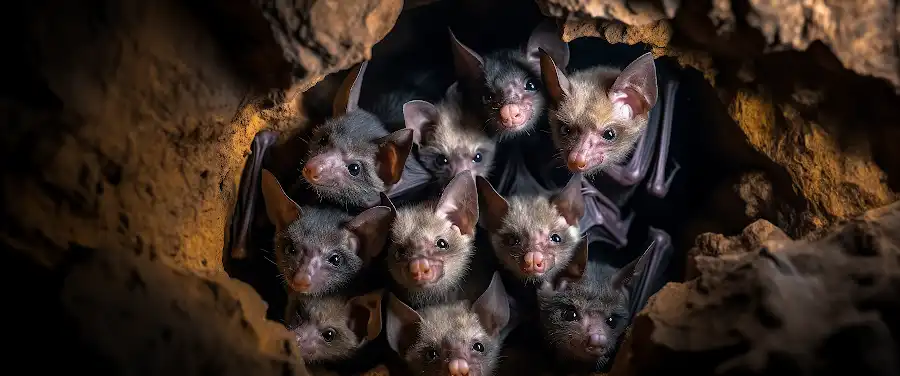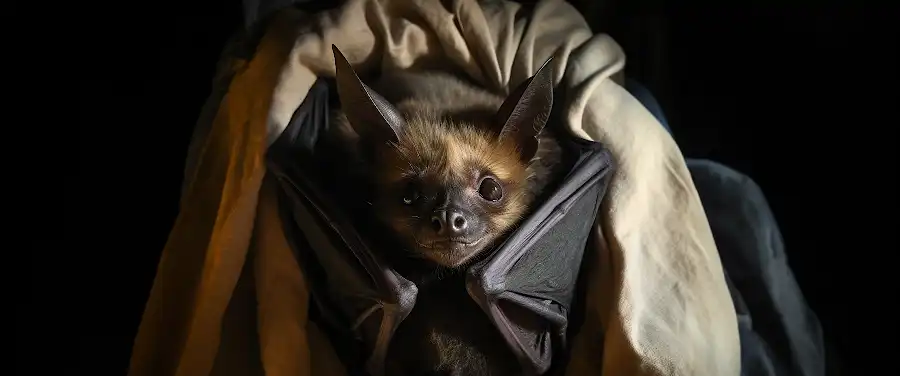
Hooked on some late-night television shows, you’ve likely stumbled upon our winged friends – bats. Ever puzzled why they retreat into creepy caves and disappear during the winter? Well, welcome aboard! We’re about to unmask the uncanny world of bats. Specifically, their intriguing habits of roosting and hibernation.
Bats, tiny creatures of the night, have managed to create complex social structures and survive potentially harsh winters through roosting and hibernation. These phrases, probably sounding like the jargon from a wildlife documentary, are surprisingly familiar in the bat territory. Roosting refers to the bats’ social gathering, where they hang upside down (Defying human logic, right?), whereas hibernation refers to their version of ‘Netflix and chill’ during winters. Incredibly, these small winged-creatures have prophesied the importance of ‘social distancing’ and ‘quarantine’ long before humans could even imagine it.
So, why are we talking about bats, roosting, and hibernation at length? Simple! These tiny residents of the night have been silently playing their part in keeping our ecosystem balanced. Their hibernation and roosting behaviors also hold critical implications for their conservation. Understanding these behaviors could be the key to protecting these critters and our ecosystem simultaneously. Stay connected as we dive deeper into the subject, explaining the “What is Bat Roosting?”. Trust me, the journey is as fascinating as the destination.
What Is Bat Hibernation?

Bat Hibernation, known scientifically as torpor, is a state of inactivity that bats enter, primarily in response to colder climates. During this period, bats drastically lower their body temperature, slow their heart rate, and decrease their metabolic activity.
How Bats Prepare for Hibernation
Bats start their preparation for hibernation, which is also a response to the scarcity of food (mostly insects), during the fall. They engage in a behavior known as swarming, congregating at the entrances of hibernation sites at dusk. This swarming behavior, often likened to a family reunion, includes feeding heavily to build up fat reserves, mating, and scouting out suitable hibernation roosts.
The Physiology of Bat Hibernation
A fascinating aspect of bat hibernation is the physiology behind it. During hibernation, a bat’s body temperature drops to match the surrounding environment, sometimes dipping as low as 2 degrees Celsius! Their heart rate decreases from an active rate of around 200-300 beats per minute to just 10 beats per minute. Combining these physiological changes allows bats to conserve energy and survive the winter months with little to no food.
How Does Bat Hibernation Differ from Other Mammals’ Hibernation?
Bat hibernation is quite unique when compared to other mammals. One of the key differences is the duration of hibernation. While some mammals hibernate only for short periods, bats can stay in hibernation for up to six months, emerging during brief warmer spells to forage and drink.
Another unique aspect of bat hibernation is their chosen hibernacula or hibernation sites. Unlike most mammals who build nests or burrow into the ground, bats often hibernate in caves, old mines, and crevices of rocks where humidity levels are high and temperature changes are minimal.
Here is a comparison between bat hibernation and hibernation of some other mammals:
| Mammal | Length of Hibernation | Body Temperature During Hibernation |
|---|---|---|
| Bats | Up to 6 months | As low as 2 degrees Celsius |
| Bears | 5-7 months | Around 31 degrees Celsius |
| Ground Squirrels | 8-9 months | Near freezing point |
| Hedgehogs | 4-5 months | Around 33 degrees Celsius |
We see that while each species hibernates to survive the cold months of winter, the conditions and duration of hibernation can vary significantly.
Understanding Bat Roosting and Hibernation is vital in our efforts to respect and conserve these remarkable creatures. In the next section, we will explore the threats to bat roosting and hibernation, and discuss what we can do to help protect them.
Conclusion
It comes down to this, folks: the fascinating world of bat roosting and hibernation might still have its mysteries, but if there’s one thing clear, it’s the indisputable importance of these practices in bat life cycles, and consequently in our ecosystems. Think about it – they not just snooze for the cooler months, they are employing an intricate survival strategy, one that’s vital for their existence and the overall balance of nature.
Whether it’s beneath the bark of your backyard tree in Central Florida or within the comforting darkness of a cave, every roost plays home for slumbering bats, a sanctuary protecting them from the shivering cold and hungry predators alike. Every roost counts, every bat counts. Recapping the importance of bat roosting and hibernation is more than just an enthralling lesson in wildlife biology. It’s a plea for understanding. A plea for conservation.
So, what can you do? Extend your support, for every little bit helps. Participate in conservation efforts – donate to a local organization, volunteer in bat surveys, install a bat house in your backyard, or simply spread awareness about the misunderstood and often vilified nocturnal wonders. Let your actions echo the need for conservation.
In the end, despite our efforts to understand, bats will always have a hint of intrigue, an aura of mystery cloaked around them. Hidden within their humble roosts during their lengthy hibernation, they continue to surprise us, to perplex us, and to educate us. We may never fully unravel the secrets of their slumber, but that, my friends, holds an appeal of its own, for it leaves us with something to constantly explore and appreciate.
With a deeper understanding of bat roosting and hibernation, one can only admire their incredible adaptability and resilience. Their world may be tucked away in the shadows, yet their significance shines bright, underlining beautifully the intricate interdependence within Mother Nature.
So go ahead, share what you’ve learnt, fuel the appreciation for these fascinating creatures, and play your part in securing their future. After all, the survival of bats is not just an ecological prerogative, but our responsibility too.
In the intriguing dance of ecosystems, every creature plays a role—including bats, you, and me. It’s all connected. It’s all important.
Be kind to bats, let their roost remain their haven, let them slumber undisturbed in the season of rest. Remember, when bats thrive, our environment inevitably flourishes too.




